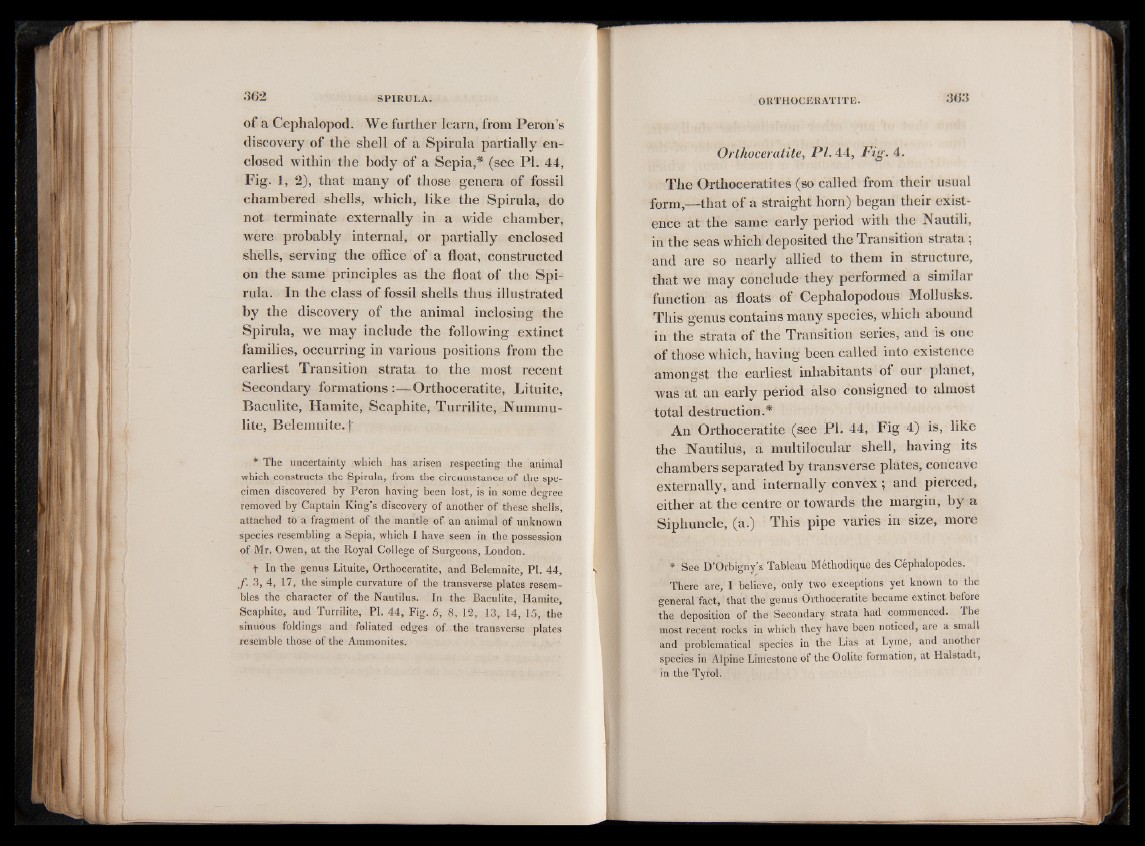
of a Cephalopod. We further learn, from Peron’s
discovery of the shell of a Spirula partially enclosed
within the body of a Sepia,* (see PI. 44,
Fig. 1, 2), that many of those genera of fossil
chambered shells, which, like the Spirula, do
not terminate externally in a wide chamber,
were probably internal, or partially enclosed
shells, serving the office of a float, constructed
on the same principles as the float of the Spirula.
In the class of fossil shells thus illustrated
by the discovery of the animal inclosing the
Spirula, we may include the following extinct
families, occurring in various positions from the
earliest Transition strata to the most recent
Secondary formations :— Orthoceratite, Lituite,
Baculite, Hamite, Scaphite, Turrilite, Nummu-
lite, Belemnite.f
* The uncertainty which has arisen respecting the animal
which constructs the Spirula, from the circumstance of the specimen
discovered by Peron having been lost, is in some degree
removed by Captain King’s discovery of another of these shells,
attached to a fragment of the mantle of. an animal of unknown
species resembling a Sepia, which I have seen in the possession
of Mr. Owen, at the Royal College of Surgeons, London.
t In the genus Lituite, Orthoceratite, and Belemnite, PI. 44,
ƒ. 3, 4, 17, the simple curvature of the transverse plates resembles
the character of the Nautilus. In the Baculite, Hamite,
Scaphite, and Turrilite, PI. 44, Fig. 5, 8, 12, 13, 14, 15, the
sinuous foldings and foliated edges of. the transverse plates
resemble those of the Ammonites.
Orthoceratite, PI. 44, Fig. 4.
The Orthoceratites (so called from their usual
form,— that of a straight horn) began their existence
at the same early period with the Nautili,
in the seas which deposited the Transition strata;
and are so nearly allied to them in structure,
that we may conclude they performed a similar
function as floats of Cephalopodous Mollusks.
This genus contains many species, which abound
in the strata of the Transition series, and is one
of those which, having been called into existence
amongst the earliest inhabitants of our planet,
wras at an early period also consigned to almost
total destruction.*
An Orthoceratite (see PI. 44, Fig 4) is, like
the Nautilus, a multilocular shell, having its
chambers separated by transverse plates, concave
externally, and internally convex; and pierced,
either at the centre or towards the margin, by a
Siphuncle, (a.) This pipe varies in size, more
* See D’Orbigny’s Tableau Méthodique des Céphalopodes.
There are, I believe, only two exceptions yet known to the
general fact, that the genus Orthoceratite became extinct before
the deposition of the Secondary strata had commenced. The
most recent rocks in which they have been noticed, are a small
and problematical species in the Lias at Lyme, and another
species in Alpine Limestone of the Oolite formation, at Halstadt,
in the Tyrol.